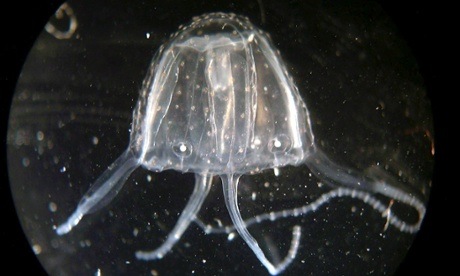
Two children have been treated for the sting of a tiny jellyfish known for producing “a sense of impending doom” in its victims.
The children, a six-year-old girl and a 10-year-old boy, were stung by Irukandji jellyfish at Honeymoon Cove beach in far-north Western Australia on New Year’s Day and 4 January respectively.
A spokesman for the WA Country Health Service said both were taken to the emergency department of the Nickol Bay hospital and “responded well” to treatment.
Jamie Seymour, an associate professor from James Cook University and recognised expert in venomous Australian animals, said symptoms from the sting of the thumbnail-sized jellyfish take 20 minutes to develop and “range from a mild headache to death”. Usually, though, they present as “intense, overall pain”.
“[People get] stomach cramps, nausea, vomiting and pain coming in waves,” Seymour said. “But it’s not a wave that comes and goes, it’s a wave that builds up. It’s progressive. It peaks, and peaks again, and peaks again.”

Then there is the sense of impending doom, which Seymour said is not yet fully understood. The leading explanation is that it is caused by excess adrenaline.
“Your body says, ‘It’s time to get out of here and do something,’ but you don’t know what to do, so you get the feeling that something bad is about to happen,” he said.
Irukandji jellyfish were discovered in Cairns in the 1960s, but between 10 and 12 species of jellyfish have been known to produce the symptoms known as Irukandji syndrome.
There have been only two recorded deaths from Irukandji syndrome in Australia. Both occurred in far-north Queensland in the early 2000s. Seymour said that, at most, there are about 30 stings a year.
The WA Country Health Service recommends that people stung by an Irukandji pour vinegar on the sting and get to a hospital as soon as possible. The intense pain raises blood pressure which “can lead to potentially fatal complications”.
Not much is known about the distribution of Irukandji jellyfish or when they are most likely to be around. In Australia they are known to be in waters from the southern tip of Fraser Island in Queensland to Exmouth in Western Australia, just 600km south of the most recent stings at Honeymoon Beach.
Seymour said while there was evidence they are heading further south, there are few comprehensive studies on distribution because the jellyfish “are pretty hard to find and if you put a foot wrong you get stung”.
Seymour said one reason for the lack of research was that until recently they were considered to be only a northern Queensland problem.
“But we know now it’s global – it’s becoming a global problem,” he said. “They are found anywhere from the tropic of cancer to the tropic of capricorn.”
An information sheet produced by the shire of Broome said there was no way to detect the jellyfish and advised all swimmers to wear a full-body stinger suit.
